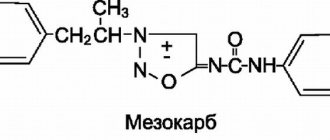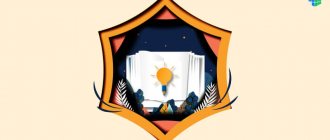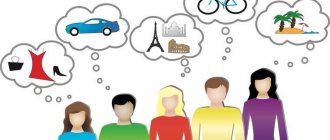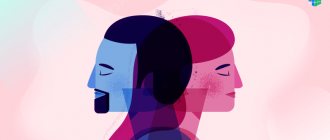Autism: what is it?
Autism is a disorder of psychological as well as mental development.
The disease is accompanied by a pronounced lack of emotional expression and lack of desire to communicate. The word “autism” itself is translated as a person who withdraws into himself. Thus, patients suffering from this disease are prone to carrying out actions that lack social meaning. Also, these people never show emotions, and there are no gestures in their interactions with others. Early childhood autism is diagnosed in preschool children. The initial symptoms of the disease, as well as the characteristics of its manifestation, depend on the form of the pathology. Most often, at the initial stage, the pathology is accompanied by disturbances in speech, gestures, and facial expressions during communication.
Causes, symptoms and signs of the disease
Autism entails a delay in the patient’s full mental development. More often than not, these children do worse than their peers at school. The disease affects the ability of an autistic child to concentrate and remember learned material.
Profound mental retardation is possible in those children whose autism was caused by other severe diseases of the brain or nervous system. The main feature of autism is selective intelligence. The fact is that some autistic people may excel in music or art, but fall significantly behind in other subjects. An example of this would be some famous figures in history who made significant contributions to science, such as Albert Einstein, who was also autistic.
It is impossible to determine externally whether a child has a disease such as autism. The exact causes of such a disorder of the nervous system are not fully known, but several main provoking factors have been named:
- Obesity and other maternal metabolic disorders.
- Cerebral palsy.
- Oxygen starvation of a child during pregnancy or childbirth.
- Infectious diseases that the mother suffered while pregnant.
- Hereditary predisposition.
Making an accurate diagnosis is possible only after a complete examination of the child. It is possible to suspect early autism if you pay attention to the child’s behavioral characteristics. Pathology is possible under the following conditions:
- the child likes to play alone and does not show a desire to communicate with others;
- cannot tolerate loud noises;
- shows nervousness when touched by others;
- always looks away when adults talk to him;
- is more often silent, does not know how to clearly explain what he wants;
- throws frequent tantrums;
- the child lacks the instinct of self-preservation.
In addition, early autism can be suspected in a passive or hyperactive child if there are additional signs of the disease listed above.
Establishing diagnosis
If you suspect the development of a disorder, you need to make an appointment with an experienced psychotherapist as soon as possible. The doctor will conduct a diagnosis that will confirm or refute the preliminary diagnosis. During the examination, the following techniques and methods are usually used:
- conversation;
- behavioral skills assessment;
- studying the characteristics of movements;
- Ultrasound of the brain;
- electroencephalography.
If the disease is confirmed, it is important not to despair and not give up. Doctors know how to make the lives of autistic people fulfilling. Call - 8(969)060-93-93.
How does autism manifest?
The disease manifests itself in the appearance of characteristic symptoms that can be detected already in the second year of the baby’s life.
Isolation from others
Parents may suspect a mild disorder of the nervous system if the child does not respond to an adult’s speech, always looks away, and does not look at the person who is addressing him. The child may laugh for no apparent reason or, conversely, will not even smile at any attempt by an adult to make him laugh.
Tries to communicate only with gestures, and does this only if there is a need to indicate to an adult his desires or needs.
He is not at all interested in communicating with his peers, and he is also unable to find contact with other kids, so he prefers to spend time alone. Such a child loves to play alone, and if another child tries to join him, he will most likely throw a tantrum or be capricious.
An additional difference between an autistic child is the lack of ability to play any role-playing games. He cannot come up with a plot for the game, and he perceives any toy completely differently, for weeks healthy children. For example, a child may be interested only in a specific part of a toy; he may spend hours looking at a wheel from a car and will not even think that this item can be used in another way, for example, rolled on the floor.
Even though a child with autism is unable to express emotions, he will still become anxious if his mother is out of sight.
Communication breakdown
Absolute absence of speech or delay in full development of speech are disorders that often occur in the youngest patients. The development of speech skills in such children depends on the severity of the disease. If a severe form of the pathology has been advanced, then the child may not begin to talk at all in the future. In some cases, patients learn to express their wishes and requests in short words. More often, speech is still present in such patients, but incoherent sentences are more like just a collection of random words.
Autistic children often have no reaction when called by name. They always talk about themselves in the third person. Their speech often does not make sense, and when asked a question, they can answer something that has nothing to do with you in the conversation.
Stereotypical behavior
This type of behavior includes:
- Daily rituals. Autistic children love to be in a familiar and comfortable environment. If any changes occur in their usual way of life, for example, rearranging furniture or moving, then they experience discomfort and anxiety. This can make a child withdraw into himself or cause him to become aggressive.
- Obsession, which manifests itself in concentrating on one activity. It is sometimes difficult to distract a child with autism from an activity to which he is willing to devote several hours.
- Intense fear. If a child often experiences stress, he may develop aggression not only towards others, but also towards himself.
- Repeated repetition of certain movements. If an autistic child finds himself in an unfamiliar environment or experiences stress, he begins to repeat the same movement over and over: swaying from side to side, fiddling with his fingers, or shaking his head.
Early symptoms of the disease
Parents may notice telltale signs of early autism in their child before he or she turns one. Children with this nervous system disease are inactive and show little or no interest in toys. Against the background of normal physical development, such children do not show a desire to learn new subjects.
Autistic disorders: types
There are several types of autistic disorders, which differ in severity and form of manifestation, and therefore require different methods of correction.
Asperger's syndrome
This is a mild form of the disease. The first symptoms begin to appear at about 7 years of age. Features of a child who has been diagnosed with this form of the disease:
- has a fairly high level of intelligence;
- speaks clearly, but loudly, has problems with intonation;
- self-centered, refuses to compromise;
- takes uncharacteristic postures and walks awkwardly due to lack of coordination;
- gets fixated on one thing.
Provided that favorable conditions for development and upbringing are created, a child with Asperger syndrome will be able to live a normal life in the future. Along with his peers, he is able to graduate from school and university, start a family, and get a job.
Rett syndrome
This is a consequence of abnormalities in the female chromosome, so the disease can only appear in girls. Boys who receive such a chromosome die during pregnancy. This syndrome is considered a severe form of the disease and occurs approximately very rarely, 1 time in 10 thousand children. The manifestation of pathology is accompanied by the following clinical symptoms:
- After birth, the child develops fully within a year, after which obvious signs of mental retardation begin to appear sharply.
- The rate of head growth after a year is significantly reduced, and impaired coordination of movements develops.
- Complete lack of speech.
- The child withdraws into himself, completely isolating himself from the outside world.
- Skills acquired before the age of one are lost.
- The child often makes meaningless repeated movements with his hands, as if washing himself.
This is a severe form of the disease, which is practically impossible to correct, so when diagnosed, in most cases the prognosis is unfavorable.
Why does it occur
When talking about whether there is a mild form of autism, one cannot help but dwell on the factors leading to its occurrence. Among them are disturbances in the activity of the human genetic apparatus that arose during the period of intrauterine development due to:
- influence of ionizing radiation;
- infection of amniotic fluid with viral or bacterial agents;
- close contact of the expectant mother with dangerous chemical compounds;
- Mom’s chronic neurological diseases, due to which she took psychotropics for a long time.
The hereditary factor cannot be written off either. It has been noticed that if one of the child’s close relatives is diagnosed with autism, the risk of the child developing the disease increases significantly.
Diagnosis of autism
Until one year is too early to talk about whether a child has a disease such as autism. Outwardly, at such an early age it is quite difficult to determine this pathology, however, experienced parents who already have older children may notice certain developmental deviations already at this age. If there are cases of autism in the family, it is important to closely monitor the child so that if characteristic symptoms of the disease are detected, medical assistance is provided in a timely manner. If the diagnosis is made as early as possible, then in the future the baby’s adaptation to the world around him will be simpler and more consistent.
Autism is diagnosed using the following basic methods:
- EEG is a research method necessary to make a diagnosis such as epilepsy. Sometimes autism can be suspected based on the fact that the patient experiences epileptic seizures.
- Examination by an otolaryngologist who tests the patient's hearing and confirms or excludes possible hearing loss.
- Brain ultrasound is a diagnostic method that can be used to identify or exclude the presence of disorders in the structure of the brain, which may lead to the appearance of symptoms of the disease.
- Testing using special questionnaires.
Autistic adults – what are they like?
People with ASD have a number of characteristics; autistic adults have a number of characteristic characteristics:
- echolalia – repetition of what was heard;
- the use of whimsical monologues;
- creating imaginary friends;
- self-harm;
- fits of rage;
- self-pity;
- stereotyping, etc.
Inability to use a smile is typical; Often people attract attention by shouting and affect.
How autistic adults live, what’s inside them:
Is autism treatable in children?
Autism is a disease that cannot be completely cured, but thanks to effective correction methods, it is possible to help a child with this pathology adapt to the world around him. With close cooperation between the baby's parents and teachers, as well as routine actions, the child's condition can be significantly improved. The result of such efforts will be tangible successes of the baby in development and adaptation.
What parents of autistic children should know and always remember:
- Your child is special, not like other children.
- A favorable family environment is the key to a child’s full development. Frequent changes and stress are factors that can contribute to the deterioration of a child’s condition.
- Regular consultations with specialized specialists should not be neglected.
In young children, autism is treated in several stages, which include the formation of the patient’s skills necessary for existence in society, the gradual development of speech rudiments, observation and subsequent elimination of behavioral disorders. In addition, it is important for such children to be taught to play role-playing games and make eye contact when talking with an interlocutor.
There are several ways to correct autism:
- Speech therapy. A speech therapist is a specialist whose regular sessions are aimed at developing intelligible speech in a child, as a result of which the patient can construct sentences correctly.
- Behavioral. It is based on observation of the patient’s behavior, which is necessary to clarify the characteristics of the course of the disease and the subsequent method of correction.
- Medication. This method of correction is used extremely rarely and only in special cases. Neuroleptics, sedatives, and psychotropic drugs are prescribed to patients who have developed destructive behavioral disorders.
- Initially, children with autism do not have basic self-care skills. Such a child does not understand why he needs to bathe every day or wash his hands every time before eating. With the help of special classes with a specialist, the patient can be taught basic self-care skills, which occurs in a relaxed playful environment.
Problems in society, life, socialization, education
When looking at photos of autistic adults, they appear aloof. It is so indeed. People suffering from the disorder sometimes appear deaf. They have problems communicating, create an impression of indifference to the environment, avoid eye contact, react passively to hugs and affection, and rarely seek comfort from others. Most autistic people cannot regulate their behavior. This can take the form of verbal outbursts or uncontrollable rages. Autistic people do not respond well to change.
Autistic people are unhappy in groups. They are loners living in their own world. Creating imaginary friends is a common trait.
Social indecisiveness determines the way autistic adults live, complicates relationships in employment, marriage, and affects family relationships.
People with autism receive basic education in special or practical schools, while others are integrated into mainstream institutions. After completing their primary education, they can attend various types of educational institutions. Some people with ASD attend universities, but due to problems with social behavior do not complete their studies.
The transition from school to work is a significant burden. Without sufficient family support or institutions that employ people with disabilities, autistic people often remain unemployed, have no money, and in some cases end up on the street. Sometimes it is possible to find a job through social rehabilitation programs.
Difference between autism and other diseases
Autism can easily be confused with some other diseases. If characteristic symptoms of pathology occur, you should not self-medicate; it is important to immediately seek advice from a specialist. Diseases that have similar clinical manifestations include:
- Schizophrenia. This mental illness is treatable, although its symptoms are very similar to autism.
- Hearing loss. This is a hearing impairment that can be either congenital or acquired. The disease causes poor development of the speech apparatus, as a result of which it is often initially confused with autism.
- Hyperactivity, in which the child does poorly in school due to restlessness and poor concentration.
- Delayed psycho-speech development also has similar symptoms to autism, but is easily corrected if you contact a specialist in a timely manner, who will prescribe a course of classes for the child.
Forecast
Autism is not as scary as it might initially seem, so parents should understand that if their child is diagnosed with this, he can grow up to be a full-fledged person, can successfully graduate from school and even start a family in the future. To do this, it is important to follow all the recommendations of specialists, create an atmosphere in the family favorable for the growth and development of the child, and provide proper care for him. It is also important to know the main symptoms of autism and carefully monitor the behavior of a child of primary preschool age in order to notice signs of such a nervous system disease in time and promptly seek help from a specialist.










